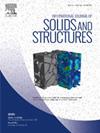An analytical model for the bending and reaction force of hygroscopic bilayers upon water adsorption
IF 3.4
3区 工程技术
Q1 MECHANICS
International Journal of Solids and Structures
Pub Date : 2024-12-09
DOI:10.1016/j.ijsolstr.2024.113191
引用次数: 0
Abstract
Hygroscopic bilayers replicating the morphing capability of plants upon hydration (e.g., pinecone scales, chiral seed pods) have gained much attention in robotics and material science research in the past decade. Due to variations in humidity, hygroscopic bilayers – comprising a passive substrate and an active porous coating – can convert the chemical potential difference of adsorbate species between the surrounding environment and the pore space to mechanical energy, resulting in development of curvature and forces. In this paper, we present a closed-form analytical model that considers the pore structure of the active layer for predicting the morphing of hygroscopic bilayers subjected to adsorption. For free-end cases, the curvature evolution as a function of relative humidity is predicted by combining a bilayer beam theory and a linear surface poroelasticity model for the active porous layer. For fixed-end scenarios, the reaction force generated by the bilayer is predicted using Castigliano’s second theorem with the same constitutive model. For validation, we consider two types of hydroscopic bilayers with microporous and mesoporous coatings, as tested by Boudot et al. (2016). A new isotherm equation is introduced to capture the adsorption characteristics of mesoporous media at all humidity levels. The predicted curvature and reaction force curves compared well against the experimental data. Finally, the effects of substrate Young’s modulus and the coating’s thickness on the response of the bilayer are studied. The proposed model offers straightforward mechanistic description of hydroscopic bilayers, thereby aiding in the future optimization and design of these systems for engineering applications.
求助全文
约1分钟内获得全文
求助全文
来源期刊
CiteScore
6.70
自引率
8.30%
发文量
405
审稿时长
70 days
期刊介绍:
The International Journal of Solids and Structures has as its objective the publication and dissemination of original research in Mechanics of Solids and Structures as a field of Applied Science and Engineering. It fosters thus the exchange of ideas among workers in different parts of the world and also among workers who emphasize different aspects of the foundations and applications of the field.
Standing as it does at the cross-roads of Materials Science, Life Sciences, Mathematics, Physics and Engineering Design, the Mechanics of Solids and Structures is experiencing considerable growth as a result of recent technological advances. The Journal, by providing an international medium of communication, is encouraging this growth and is encompassing all aspects of the field from the more classical problems of structural analysis to mechanics of solids continually interacting with other media and including fracture, flow, wave propagation, heat transfer, thermal effects in solids, optimum design methods, model analysis, structural topology and numerical techniques. Interest extends to both inorganic and organic solids and structures.

 求助内容:
求助内容: 应助结果提醒方式:
应助结果提醒方式:


